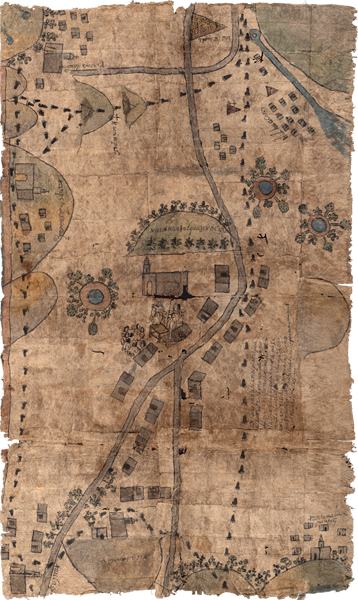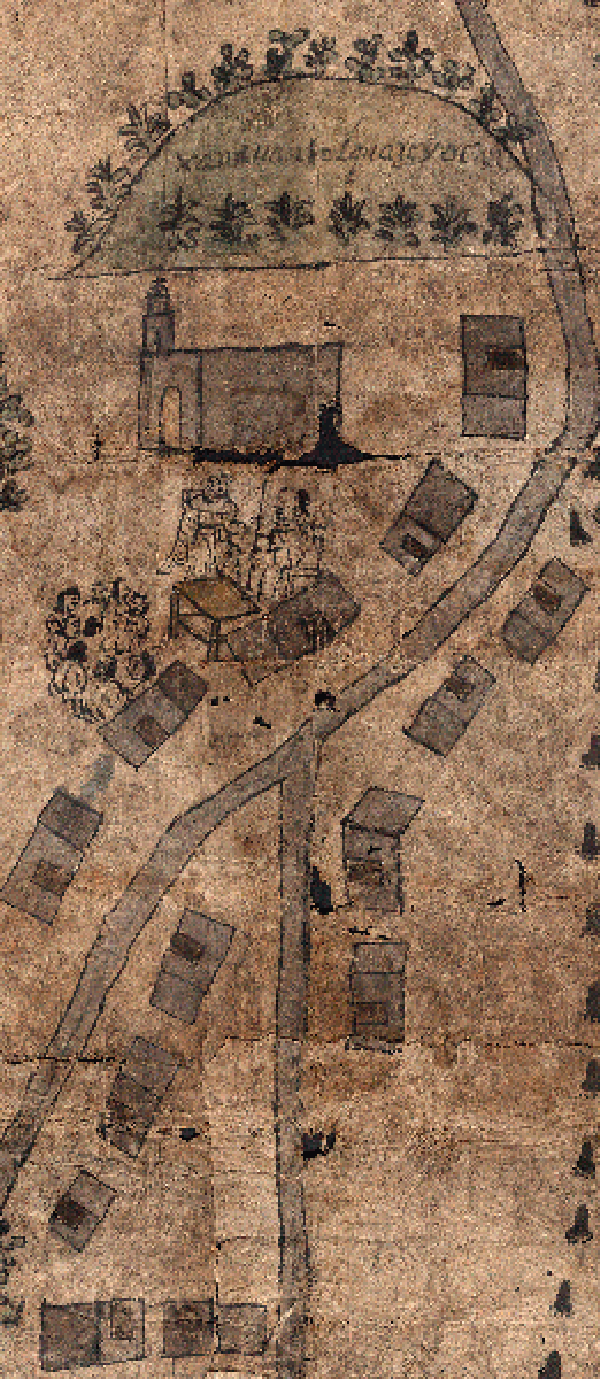pueblo of San Juan Tolcayuca
This detail captures the central community of this manuscript, now called San Juan Tolcayuca, in the state of Hidalgo, Mexico. This town is located at a latitude of 19.95000 and a longitude of -98.91667 (source: http://www.travelpost.com/NA/Mexico/Hidalgo/Tolcayuca/7681856). The municipality is located fairly near the border with the state of Mexico. It is also a little more than 17 miles south and slightly west from Pachuca, the capital of the state of Hidalgo.
A hill with a green watercolor wash bears the town name, Xan Xuan Tolquauyocan, as rendered in fairly typical Techialoyan orthography. The hill crest is adorned with what appear to be nopal and maguey cacti. The base of the hill has another full row of magueyes (agaves). The Christian church is the heart of the community. It is outlined in black ink and is painted here with a dark gray watercolor. There is a bell tower with two segments, including arched openings, and a cupola with cross on top. The doorway or entrance to the church is painted a yellow or gold color. There is much deterioration at the base of the church, where the manuscript was once folded. Human activity typically occurs in the open spaces near the church. Small buildings, probably meant to represent the housing core, line the roads that cut through the town. These are small, flat-roofed, box-like structures outlined in black ink and painted gray, with brown doorways. The roads are also outlined in black and painted gray. The road has a notable fork very near what may be the center of town.
The scene with the people either overlaps with or is crowded by the representations of houses, as though one or the other was added at a later time, without planning sufficient space for both. The table, outlined in black ink and colored a yellowish brown, is only partially visible.
In the activity, a Spanish friar and an indigenous leader, the latter holding a staff of office, sit on chairs at the table, while eight or nine indigenous women sit on the ground nearby. The women’s proximity to the earth is possibly related to their ancient association with the terrestial realm. They sit upon their legs in an age-old fashion. The considerable number of women is notable. The indigenous male probably held the highest office on the town council, or cabildo, as instituted by the Spanish colonial government. These figures are only outlined in black, although the women’s hair is colored in with this same black ink, presumably.
pueblo de San Juan Tolcayuca
Este detalle del manuscrito captura a la comunidad central ahora llamada San Juan Tolcayuca, en el estado de Hidalgo, México. El pueblo se encuentra ubicado a 19.95 grados de latitud y -98.91667 de longitud (fuente: http://www.travelpost.com/NA/Mexico/Hidalgo/Tolcayuca/7681856). La municipalidad se encuentra ubicada cerca de la frontera con el estado de México. Está un poco más de 17 millas al sur de Pachuca, la capital del estado de Hidalgo.
Una colina pintada con acuarelas verdes contiene el nombre del pueblo, Xan Xuan Tolquauyocan, escrito según la ortografia típica Techialoyana. La parte superior de la colina está adornada con lo que parece ser un nopal y un maguey. La base tiene una hilera llena de magueyes (agaves). La iglesia cristiana es el corazón de la comunidad. Está delineada en tinta negra y está pintada con acuarelas de color gris oscuro. Hay un campanal con dos segmentos, incluyendo aperturas archeadas, y una cúpula con una cruz en la cima. La entrada a la iglesia está pintada de amarillo o de color oro. El manuscrito presenta una gran deterioración a la altura de la base de la iglesia, donde el documento fue doblado. En los espacios alrededor de la iglesia generalmente se puede apreciar actividad humana. A ambos lados del camino que recorre el pueblo se encuentran pequeñas viviendas , seguramente representando áreas residenciales. Estas viviendas son pequeñas, de techos planos, con forma de cubo delineadas en tinta negra y pintadas de gris, con las puertas marrones. Los caminos también están delineados en negro y pintados de gris. El camino se bifurca en lo que puede ser el centro de la ciudad.
La escena con las personas se superpone con o es llenado con las representaciones de casas, lo que parecería indicar que una de las dos fue agregada posteriormente a la creación del documento, sin haber planeado suficient espacio para las dos. La mesa, delineada en tinta negra y coloreada con un café amarillo, es parcialmente visible.
En la actividad, un fraile español y un líder indígena sosteniendo un bastón ceremonial, se encuentran sentados en sillas alrededor de la mesa, mientras que ocho o nueve mujeres indígenas están sentadas en el suelo alrededor. La proximidad de las mujeres a la tierra puede ser relacionada posiblemente a su antigua asociación con el reino terrenal. Están sobre sus piernas, en una postura antigua. La cantidad de mujeres es considerable. El hombre indígena probablemente tenia el cargo mas alto en el consejo, o cabildo, institución concebida por el gobierno colonizador español. Esta figuras están sólamente delineadas en negro, aunque presumiblemente, el pelo de las mujeres fueron pintados con esa misma tinta negra.

